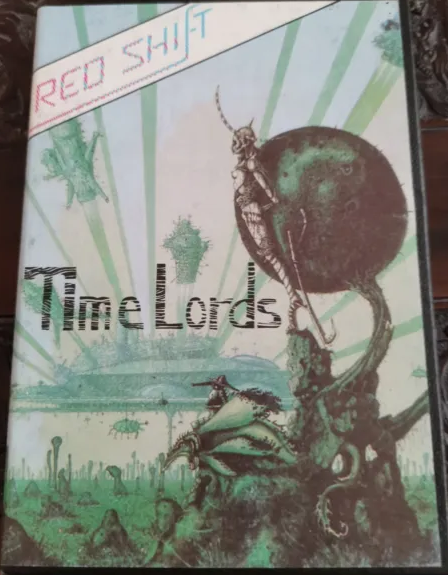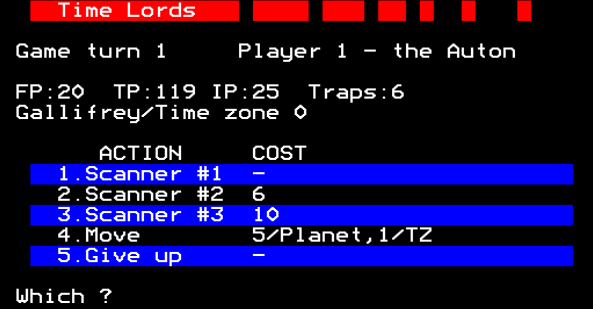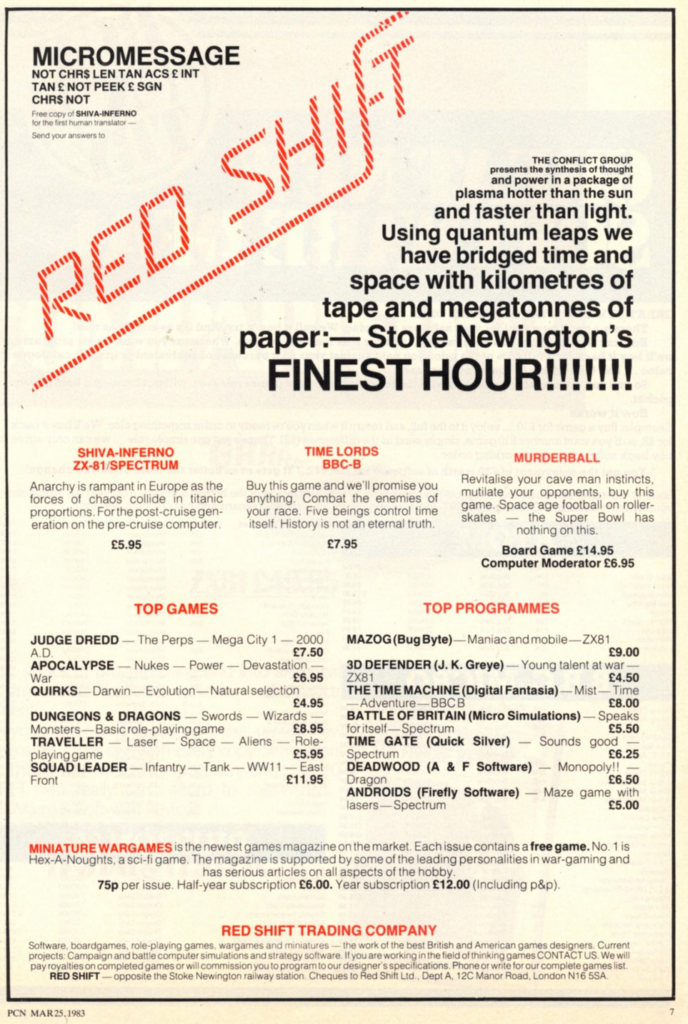
As always, this article assumes you have read the Time Lords After Action Report.
Julian Gollop’s father introduced him to board games at a young age. A precocious designer, Gollop realized around the age of 6 or 7 years that Chess, then his favorite game, had a design issue : “the best players learn the best library of opening moves and sequences, and the initial setup always being the same can make chess a bit boring.” To fix this, he rotated the board 45 degrees and created a new set of rules where players would start on opposing diagonals, though he did not submit the design to the International Chess Federation.
For his 10th birthday, in 1975, Gollop received Escape from Colditz. The game struck a chord with him, perhaps because it was the first game which was neither a cold battle of the minds like Chess or Backgammon, nor a dusty classic like Monopoly ; it had instead a powerful theme, complex rules and was tense from start to finish. Starting around 11, Gollop started to create his own games from whole cloth, or rather whole counters and figurines, and he scrapped the games he owned to create new ones of increasing complexity. His first players were his siblings, particularly his older brother Nick, but his player base expanded in 1979 or 1980 with two brothers Gollop had met at school : Simon and Andrew Greene. Together, they also played the best the gaming market had to offer, whether boardgames, wargames or of course that new fad : RPGs.
In the early 1980s, while Gollop was in college in Harlow, he accumulated a significant number of high-quality game designs, far surpassing the hastily put together prototypes of his earlier years. Two of his most notable designs were Wizard Wars (the future Chaos) and Time Lords. The latter, he described as follows :
There were no components apart from a piece of paper, a pencil, and an eraser. Each player had to have their own piece of paper, and there were some dice involved. […] As they rolled dice to travel to planets, the game master consulted dice and documents to inform them what they found at each location. With luck, they discovered a civilization whose people would share their history as far back as their time zone permitted them to remember it. Should that history include a war, players could travel back in time and alter history for themselves and every other player and race. This would have to be marked on the game master’s sheet, because the survivors got changed, so the game master updates the universe plan while each player only has their own view of the universe based on the time zones they’ve visited and the history they can extract from civilizations. […] It got a bit complicated to manage by hand.”
One day, one of Gollop’s college teachers showed the class a new contraption : a Commodore PET. Initially uninterested, Gollop had an epiphany when he saw Star Trek in action : the computer could replace the thankless role of game master and manage seamlessly the hidden movements ! Gollop immediately understood how powerful a tool it was for game design, and he soon acquired a second-hand ZX80 for £25. The ZX80 had a paltry 1 mo of RAM but it was enough, the very night of the purchase Gollop plugged it to the family TV and started learning BASIC. As for the Greene brothers were less impressed by the Commodore PET. They already had access to a Sharp MZ-80K, on which they learned BASIC by copying type-in codes. Soon enough the Greene developed their own games. Andrew gave as an example “Gangs“, a most British game as the player had to “maintain a gang of schoolboys over a school holiday, with accompanying financial management and risk of apathy resulting in the message ‘Gang fizzled’ if they disbanded before the end of the holiday.”
When the Greene brothers upgraded to a BBC Micro in 1982 – around the same time that Gollop had acquired his ZX80 – they looked for more ambitious projects making full use of the capabilities of their new electronic steed. Gollop’s many games were prime candidates, and they asked him whether they could port Wizard Wars. Gollop agreed, and the brothers proved worthy of the task enough that it was then Gollop who asked whether they could port Time Lords. After much difficulty, Gollop and the siblings finished the port. It was slow, it looked like an accounting spreadsheet, but it was playable. It had been a great learning experience, and Gollop was eager to test his skill by coding his next game alone : Nebula. As for Time Lords, it was shelved. What else could they do with it ? Publish it ? Ha !


Unrelated to these developments, in late 1982, two friends from London, Julian Fuller and Helmut “Woof” Watson, both unemployed, had decided to turn their hobby into a job by launching a wargaming magazine : Miniature Wargames. The initial financing came from Stanley Gee, a friend of Watson’s father – also a wargamer. As luck would have it, their new office was upstairs to a vacant shop, which they used, with Gee’s financial backing, to open a wargame and video game shop called Conflict. The offering of wargames was splendid, but Fuller and Watson lamented over the quality of the available video games. They vowed to fix the issue by creating their own – better – video game company and, yet again pulling from Gee’s deep pockets, Fuller, Watson, and two extra friends (Norman Clive and Bob Tyler) founded Red Shift. With a team of 5, Red Shift instantly became one of the most staffed video game companies in the UK. Now they just had to find the games.

While Watson and Tyler immediately started coding, one can only go so fast. Meanwhile, through a common wargaming friend, Gollop’s Time Lords reached Red Shift. It was exactly the kind of game they were looking for – it was a finished product, to start with, even if a bit crude. It became one of the 3 programs featured in the first Red Shift ad in Personal Computer News. The two others, Shiva-Inferno and Murderball, were never advertised again and are now lost.

The first version of Time Lords released by Red Shift and which Gollop apparently had to sometimes sell personally at Computer Fairs, was the Excel-looking one – we know this because it is described with enough details in a scathing review of the game in the July 1983 issue of Personal Computer News. The reviewers concluded by saying : “In theory, I suspect it could be tremendous fun… it’s a fabulous idea. But Red Shift should nip back to Time Zone 1 and have a meddle with the program and the documentation”. And Red Shift did just that – it retired the game, with no more ads after July 1983.

Red Shift could afford to retire Time Lords. Earlier in 1983 Watson had met Ian Livingstone, co-founder of Games Workshop, and showed him some of the things Red Shift was doing. Livingstone was unimpressed by the designs he saw, but quite interested in the technology. Watson walked in hoping that Games Workshop would publish one of his games, he walked out with a contract to port one of their games : Apocalypse. Bruised ego aside, the project proved profitable, enough so that Apocalypse received 3 expansion kits and Games Workshop licenced another game : Battlecars.
Here, the timeline is blurry. What’s sure is that Gollop joined Red Shift as an official member of the staff in late 1983 or early 1984, where he worked with others on Battlecars but also on his own projects. In the ZX Microfair in December 1983, Red Shift showed a “pre-production” version of Gollop’s Nebula, with the game being available at the same time as the more famous Rebelstar Raiders around March 1984. It is only after Rebelstar Raiders was released that Gollop and Greene move back to Time Lords. With more experience and possibly the help from other folks at Red Shift, they made the game pretty and optimized the code so well they could add the companions and the segments to the game. Just in case, they also changed a few letters here and there to the names so the game would totally-not-be Doctor Who anymore. This version – the one I played – was released around May or June 1984. As for Islandia, Gollop and Greene probably started it around May 1984 and it was released in the last quarter of 1984.
This ends Gollop’s history with Red Shift. Gollop had made the mistake of not negotiating any royalties on his game, instead receiving a meager salary. Meanwhile Gee, who had been the only one able to put cash on the table when Red Shift was founded, considered that the cash now generated by Apocalypse, Rebelstar Raiders and the other games was his. This point of view was not shared by the other founders who were struggling financially. In June 1984, Watson and the rest of the developers left Red Shift to found the SLUG cooperative, taking the source code for Battlecars and the great relationship with Games Workshop with them. Gollop joined them, though possibly not immediately. What happened then is a story for another time.
As a last echo of Gollop’s stint at Red Shift, Personal Computer News reviewed Time Lords a second time in February 1985 – the game had been sufficiently “meddled with” and had now reached its potential : “It’s a challenge and enjoyable game but also mind-boggling”.

Sources
Sadly, I was not able to speak to Julian Gollop, and the sources are all over the places on the exact timeline.
- Grand Thieves and Tomb Raiders: How British Video Games Conquered the World by Magnus Anderson and Rebecca Levene
- Monster in the Dark, the making of X-Com : UFO Defense by David L. Craddock
- The Digital Antiquarian – XCOM
- Interview at Eurogamer : The Story of X-Com
- Interview at RetroGamer
- Home Computing Weekly, 24 May 1983,
- Home Computer Weekly, 13 December 1983 – All that’s new at the Microfair
- Popular Computing Weekly, 23 March 1983 – Come the Revolution
- Micro Adventurer, July 1984 – Programs to fight your battle for you
- Micro Adventurer, September 1984 – Games Workshop goes Soft
- Game Computing, January 1985 – Red Shift
- Both reviews can be found in Personal Computer News (21 July 1983 and February 1985).
- I leveraged Spectrum Computing‘s massive ad database to date the game as well as I could.
Rating and Review
Time Lords by Julian Gollop and Andrew Greene, published by Red Shift, UK
First release : March 1983 on BBC Micro
Tested on : BeebEm (BBC Micro emulator)
Total time tested : Around 8 hours
Average duration of a campaign: 15 minutes in solitaire
Complexity: High (3/5)
Would recommend to a modern player : No
Would recommend to a designer : No
Final Rating: Flawed and obsolete
Ranking at the time of review : 53/85
Summary
Designed by Julian Gollop at only 18 and coded by his friend Andrew Greene, Time Lords is unique in its scope, but fails both in multiplayer and in solitaire due to the lack of agency given to the player and insane impact of the initial seeding, with many games already decided when the world is generated.
A. Immersion
Adequate. The game is not pretty, and there is almost no chrome, but the topic of the game is so unique I have to award extra points.
B. UI , Clarity of rules and outcomes
Poor. The manual is lost, but the game is explained in a data dump of 30 (thirty !) screens when launching the game. Edit 04/05/2023 : the 30 screens are actually a samizdat of the manual that whoever preserved the game by uploading it on Internet integrated at the beginning. If you are curious, Argyraspide collected them all here. Even with 30 screens of context and rules, there are many features that none of us understood well.
- What is the effect of Time Traps ? We suspect they might not even work at all !
- Where to find companions ?
- How are the combat results decided ? How big of an advantage is one Influence Point or one Fortification Point ?

There are even worse issues, for instance in our game we had to rerun turns because a player triggered an end screen (time paradox ?) when going to a specific location, but not to another. The AAR actually ended like this – the Human player should have had extra moves, but was never allowed to use them.
C. Systems
Very poor. The ruleset is one of the most unique I have ever seen, but it is cursed by gamebreaking flaws :
The only leverage you have on history is changing the results of war. While those happen frequently, what you are really looking for is a war that your race is part of and is not already winning (which excludes all fratricide wars). Those are rare enough that when you find one, the no-brainer decision is to spend as many Influence Points as possible to reverse the result, and no-brainer decisions don’t make good strategy games. Even then, you are at the mercy of the starting history line : if your race is not splitting a lot, or if another race is never challenged on a planet, no amount of race winning will allow you to win. The game would have been so much better if the Influence Points could have been used to force a race to split and immigrate, or cancel immigration, or change target in a war.
The other features of the games are either exploration (which is fine), attack or defense from other Time Lords in multiplayer. Here again the game fails : it is too easy to die, and the effects are too drastic. If you are killed in a location you went early in the game, then ALL your actions are cancelled. Full elimination in multiplayer games is rarely fun, but this manages to be even worse.
D. Scenario design & balancing
Very poor. There is no AI, and the initial random generation does not try to output something playable :
- In solitaire, most starting situations are pretty much impossible to win : according to the rules your race must have more points than all other races combined at the end of the game, a feat neither the Data Driven Gamer nor me ever came close to achieve in our game,
- In multi-player, several players will start in situation where there is nothing they can possibly do, and they will only know it at the end of the game,
At least, in solitaire, the short length of a session (15-20 minutes) makes the randomness of it all slightly more acceptable.
E. Did I make interesting decisions ?
No.
F. Final rating
Flawed and obsolete. I cannot call it “totally obsolete” because there is to my knowledge no other game with this theme, but the only interesting part is the early exploration of history, when you try to leverage limited information to understand the world.
Still, at only 18 years old Gollop had designed a game different from anything else on the market, whether computer and tabletop, whether European or American. I know you all want me to jump directly to Rebelstar Raiders, but this blog will first make a stop at Gollop’s other forgotten games, starting with Islandia. I hope to find something as original as Time Lords, and ideally slightly better balanced.